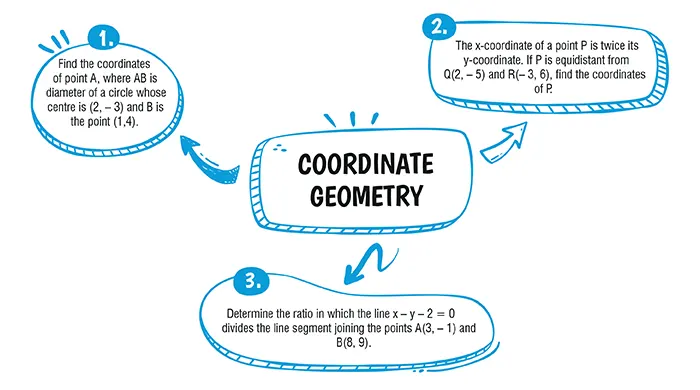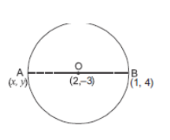Table of Contents

Ans.(b)
Explanation:
In the second quadrant, X-axis is negative and Y-axis is positive. Therefore, for a point the
abscissa is negative and the ordinate is positive.
Ans. (b)
Explanation:
Let, k : 1 be the ratio in which the X-axis divides the line joining (6,4) and (1,-7).
Let, P be the point on the X- axis that divides the line.
\text{Then} \space \space P(x,y)=\begin{pmatrix} \dfrac{k+6}{k+1},\dfrac{-7k+4}{k+1}\end{pmatrix} \\[4.5 bp]
\text{As P(x,y) lies on X-axis } \space P(x,0)=\begin{pmatrix} \dfrac{k+6}{k+1},\dfrac{-7k+4}{k+1} \end{pmatrix} \\[4.5 bp]
\text{[∵ x- coordinate will be (x,0)]} \\[4.5 bp]
\Rightarrow \dfrac{-7k+4}{k+1}=0 \\[4.5 bp]
⇒ -7k+4 = 0 \\[4.5 bp]
⇒ 7k=4 \\[4.5 bp]
\Rightarrow k= \dfrac{4}{7} \\[4.5 bp]
\text{So, the required ratio be} \space \space
k : 1 =\dfrac{4}{7}:1= 4 : 7
Explanation:
Let the coordinates of point A be (x,y) and point O (2,-3) be the center,
then,
\text{By mid-point formula,}\space\space\space\space\space\space\space\space \dfrac{x+1}{2}=\text{2 and }\dfrac{y+4}{2}=-3 \\[4.5 bp]
or x = 4 - 1 and y =- 6 - 4
\Rightarrow \space\space\space\space\space\space\space\space \text{x = 3 and y = - 10} \\[4.5 bp]

Explanation:
Let the coordinates of point P be (2y, y). Since , P is equidistant from Q and R.
\therefore \space\space\space\space\space\space\space\space PQ = PR \\[4.5 bp]
\Rightarrow \space\space\space\space\space\space\space\space \sqrt{(2y-2)^2+(y+5)^2}=\sqrt{(2y+3)^2 + (y-6)^2}\\[4.5 bp]
\Rightarrow \space\space\space\space\space\space\space\space (2y-2)^2 + (y + 5)^2= (2y + 3)^2 + (y - 6)^2 \\[4.5 bp]
\Rightarrow \space\space\space\space\space\space\space\space 4y^2 + 4 - 8y + y^2 + 25 + 10y = 4y^2 + 9 + 12y + y^2 + 36 - 12y \\[4.5 bp]
\Rightarrow \space\space\space\space\space\space\space\space 2y + 29 = 45 \\[4.5 bp]
\Rightarrow \space\space\space\space\space\space\space\space 2y = 45 - 29 \\[4.5 bp]
\Rightarrow \space\space\space\space\space\space\space\space y=\dfrac{16}{2} = 8
Hence, the coordinates of point P are (16,8).
Explanation:
Given, A = (3, – 1), B = (8, 9) and x – y – 2 = 0
Let the line x – y – 2 = 0 intersect the line segment AB at R in the ratio p : 1.
Now, Rx = \dfrac{1(3)+p(8)}{p+1} \space \space and \space \space R_y =\dfrac{1(-1)+p(9)}{p+1} \\[4.5 bp] \Rightarrow \space\space R_x =\dfrac{3+8p}{p+1} \space\space and \space\space R_y =\dfrac{-1+9p}{p+1}\\[4.5 bp] \text{Thus,} \space \space R = \begin{pmatrix} \dfrac{3+8p}{p+1},\dfrac{9p-1}{p+1} \end{pmatrix} \\[4.5 bp]
Now substituting the value of R in the given equation,
\text{we get} \\[4.5 bp] \dfrac{3+8p}{p+1}-\dfrac{9p-1}{p+1}-2=0 \\[4.5 bp] \Rightarrow\space\space\space\space 3 + 8p – 9p + 1 – 2(p + 1) = 0 \\[4.5 bp] \Rightarrow\space\space\space\space 4 – p – 2p – 2 = 0 \\[4.5 bp] \Rightarrow\space\space\space\space 3p = 2 \\[4.5 bp] \Rightarrow\space\space\space\space P=\dfrac{2}{3}\\[4.5 bp] \text{Thus, the ratio is} \space \dfrac{2}{3} : 1 = 2 : 3.| Chapter No. | Chapter Name |
|---|---|
| Chapter 1 | Real Numbers |
| Chapter 2 | Polynomials |
| Chapter 3 | Pair of Linear Equations in Two Variable |
| Chapter 4 | Quadratic Equations |
| Chapter 5 | Arithmetic Progressions |
| Chapter 6 | Triangles |
| Chapter 7 | Coordinate Geometry |
| Chapter 8 | Introduction to Trigonometry |
| Chapter 9 | Some Applications of Trigonometry |
| Chapter 10 | Circles |
| Chapter 11 | Areas Related to Circle |
| Chapter 12 | Surface Areas and Volumes |
| Chapter 13 | Statistics |
| Chapter 14 | Probability |
| Chapter Wise Important Questions for CBSE Board Class 10 Maths |
|---|
| Real Numbers |
| Polynomials |
| Pair of Linear Equations in Two Variables |
| Quadratic Equations |
| Arithmetic Progressions |
| Triangles |
| Coordinate Geometry |
| Introduction to Trigonometry |
| Some Applications of Trigonometry |
| Circles |
| Areas Related to Circles |
| Surface Areas and Volumes |
| Statistics |
| Probability |
CBSE Important Questions Class 10
ICSE Important Questions Class 10
CBSE Important Questions Class 10
ICSE Important Questions Class 10